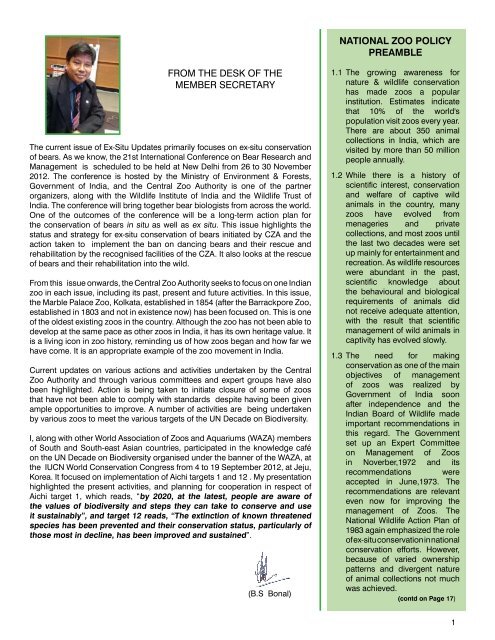Ex-Situ updates - Central Zoo Authority
Ex-Situ updates - Central Zoo Authority
Ex-Situ updates - Central Zoo Authority
You also want an ePaper? Increase the reach of your titles
YUMPU automatically turns print PDFs into web optimized ePapers that Google loves.
FROM THE DESK OF THE<br />
MEMBER SECRETARY<br />
The current issue of <strong>Ex</strong>-<strong>Situ</strong> Updates primarily focuses on ex-situ conservation<br />
of bears. As we know, the 21st International Conference on Bear Research and<br />
Management is scheduled to be held at New Delhi from 26 to 30 November<br />
2012. The conference is hosted by the Ministry of Environment & Forests,<br />
Government of India, and the <strong>Central</strong> <strong>Zoo</strong> <strong>Authority</strong> is one of the partner<br />
organizers, along with the Wildlife Institute of India and the Wildlife Trust of<br />
India. The conference will bring together bear biologists from across the world.<br />
One of the outcomes of the conference will be a long-term action plan for<br />
the conservation of bears in situ as well as ex situ. This issue highlights the<br />
status and strategy for ex-situ conservation of bears initiated by CZA and the<br />
action taken to implement the ban on dancing bears and their rescue and<br />
rehabilitation by the recognised facilities of the CZA. It also looks at the rescue<br />
of bears and their rehabilitation into the wild.<br />
From this issue onwards, the <strong>Central</strong> <strong>Zoo</strong> <strong>Authority</strong> seeks to focus on one Indian<br />
zoo in each issue, including its past, present and future activities. In this issue,<br />
the Marble Palace <strong>Zoo</strong>, Kolkata, established in 1854 (after the Barrackpore <strong>Zoo</strong>,<br />
established in 1803 and not in existence now) has been focused on. This is one<br />
of the oldest existing zoos in the country. Although the zoo has not been able to<br />
develop at the same pace as other zoos in India, it has its own heritage value. It<br />
is a living icon in zoo history, reminding us of how zoos began and how far we<br />
have come. It is an appropriate example of the zoo movement in India.<br />
Current <strong>updates</strong> on various actions and activities undertaken by the <strong>Central</strong><br />
<strong>Zoo</strong> <strong>Authority</strong> and through various committees and expert groups have also<br />
been highlighted. Action is being taken to initiate closure of some of zoos<br />
that have not been able to comply with standards despite having been given<br />
ample opportunities to improve. A number of activities are being undertaken<br />
by various zoos to meet the various targets of the UN Decade on Biodiversity.<br />
I, along with other World Association of <strong>Zoo</strong>s and Aquariums (WAZA) members<br />
of South and South-east Asian countries, participated in the knowledge café<br />
on the UN Decade on Biodiversity organised under the banner of the WAZA, at<br />
the IUCN World Conservation Congress from 4 to 19 September 2012, at Jeju,<br />
Korea. It focused on implementation of Aichi targets 1 and 12 . My presentation<br />
highlighted the present activities, and planning for cooperation in respect of<br />
Aichi target 1, which reads, “by 2020, at the latest, people are aware of<br />
the values of biodiversity and steps they can take to conserve and use<br />
it sustainably”, and target 12 reads, “The extinction of known threatened<br />
species has been prevented and their conservation status, particularly of<br />
those most in decline, has been improved and sustained”.<br />
(B.S Bonal)<br />
NATIONAL ZOO POLICY<br />
PREAMBLE<br />
1.1 The growing awareness for<br />
nature & wildlife conservation<br />
has made zoos a popular<br />
institution. Estimates indicate<br />
that 10% of the world's<br />
population visit zoos every year.<br />
There are about 350 animal<br />
collections in India, which are<br />
visited by more than 50 million<br />
people annually.<br />
1.2 While there is a history of<br />
scientific interest, conservation<br />
and welfare of captive wild<br />
animals in the country, many<br />
zoos have evolved from<br />
menageries and private<br />
collections, and most zoos until<br />
the last two decades were set<br />
up mainly for entertainment and<br />
recreation. As wildlife resources<br />
were abundant in the past,<br />
scientific knowledge about<br />
the behavioural and biological<br />
requirements of animals did<br />
not receive adequate attention,<br />
with the result that scientific<br />
management of wild animals in<br />
captivity has evolved slowly.<br />
1.3 The need for making<br />
conservation as one of the main<br />
objectives of management<br />
of zoos was realized by<br />
Government of India soon<br />
after independence and the<br />
Indian Board of Wildlife made<br />
important recommendations in<br />
this regard. The Government<br />
set up an <strong>Ex</strong>pert Committee<br />
on Management of <strong>Zoo</strong>s<br />
in Noverber,1972 and its<br />
recommendations were<br />
accepted in June,1973. The<br />
recommendations are relevant<br />
even now for improving the<br />
management of <strong>Zoo</strong>s. The<br />
National Wildlife Action Plan of<br />
1983 again emphasized the role<br />
of ex-situ conservation in national<br />
conservation efforts. However,<br />
because of varied ownership<br />
patterns and divergent nature<br />
of animal collections not much<br />
was achieved.<br />
(contd on Page 17)<br />
1
















